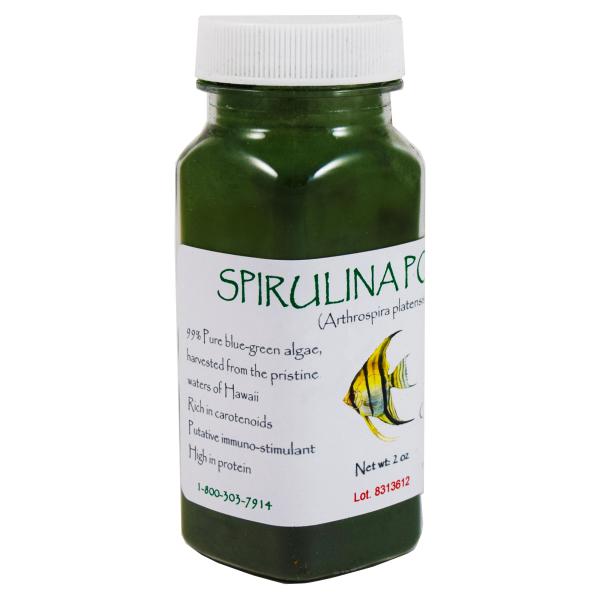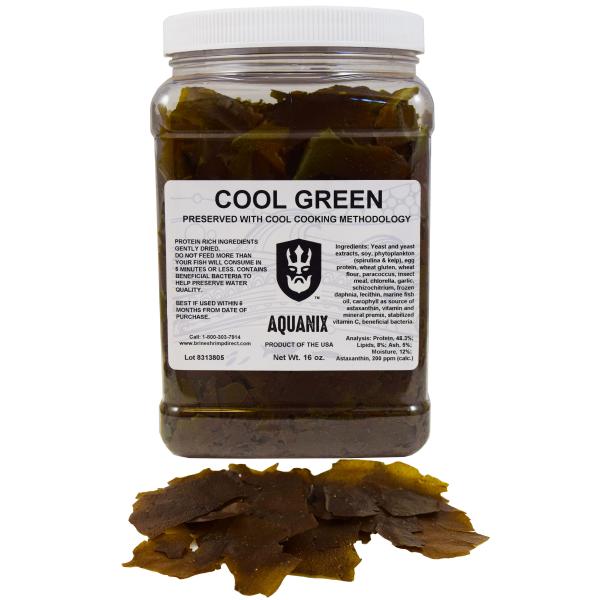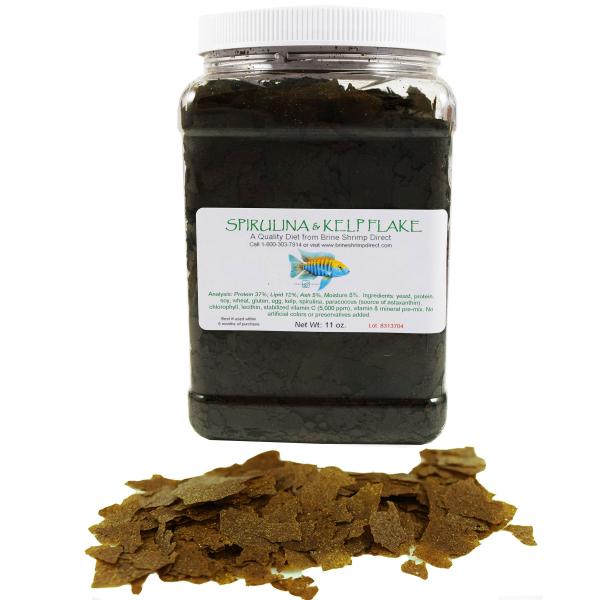Spray-dried Spirulina powder (Arthrospira platensis), is one of the most concentrated sources of protein available for use in the feeding and cultivation of aquatic animals. More accurately identified as a blue-green cyanobacterium, spirulina powder contains valuable nutritional, medicinal, and color-enhancing compounds of interest to fish-keepers.
Early interest in Spirulina focused mainly in its potential as a source of protein and vitamins. Spirulina is as much as 60-70% protein by dry weight. Grown in alkaline waters, it is also an excellent source of trace minerals (7 – 9% by dry weight). Spirulina contains significant amounts of calcium, niacin, potassium, magnesium, B vitamins and iron.
Spirulina is a Rich Source of Carotenoids
Ornamental fish have always been prized for their vivid colors. For that reason, breeders of ornamental fish have an economic interest in the visual appeal of the fish they produce. Unfortunately, the colors of fish kept in captivity can quickly fade with time, especially when fed rations formulated for food fish or rations devoid of the color-enhancing compounds collectively known as carotenoids. Fortunately, spirulina in the diet provides an accessible and rich cocktail of various carotenoids. In fact, the bluish-green spirulina contains ten times the β-carotene of carrots (Algae Industry Magazine, March 2011).
Spray-dried spirulina contains 3000-4870 ppm of carotenoids* consisting of zeaxanthin, β-carotene, echinenone and others. A number of feed trials have shown that over the course of 6-8 weeks, ornamental fish fed diets that include as little as 0.5-2% spirulina exhibited more intense coloration than those fish fed diets absent a source of carotenoids (Achieving Natural Coloration in Fish Under Culture, Ako, et.al., 1999).
Pigmentation in cultured shrimp is of economic importance. Coloration in koi is also a key determinant of value. These aquatic animals are often subjects in studies to determine the effects of carotenoids in the diet on increased pigmentation and color. When fed spirulina the results are definitive. Both penaeid shrimp and cyprinids convert carotenoids to astaxanthin, as evidenced by increased pigment deposition in the carapace and scales, respectively. Inclusion rates of as little as 3% spirulina in the diet resulted in better growth, coloration and feed conversion in shrimp than those fed no spirulina (“A Review of Spirulina as a Carotenoid and Vitamin Source for Cultured Shrimp,” Lorenz; Spirulina Pacifica Technical Bulletin #050, Nov. 1998). In a separate study with clownfish, an inclusion rate of as little as 25 ppm astaxanthin, produced a positive response in coloration (Ako, et.al., 1999).
The preponderance of scientific research shows that colors can be enhanced in captive fish by supplying diets formulated with spirulina. Further, the most efficacious diets include natural sources of carotenoids. At Brine Shrimp Direct we understand the importance of vibrant colors in fish. That is why include significant amounts of spirulina in nearly all of our formulated diets – in both our conventional flake and our unique COOL FLAKE lines, as well as in our prepared gel diets and in some of our frozen formulations.
Spirulina Can Reduce Reliance on Antibiotics
Diets containing relatively small amounts of spirulina can reduce reliance on antibiotics and other toxic medications. Antibiotic resistance in aquaculture has also generated interest in spirulina as a natural immuno-stimulant in both fish and shrimp, effectively boosting the immune system in these animals to function at a higher level of activity (Live Spirulina as a growth and immunity promoter for Nile tilapia challenged with pathogenic Aeromonas, Ahmad, 2009).
Orally feeding your fish a diet containing Spirulina could effectively reduce or eliminate the need for bath treatments. Using Spirulina algae as a "prophylactic" treatment in place of antibiotics can effectively reduce wastewater pollutants, eliminating costly treatment systems and increase the effectiveness of existing systems.
*Levels of carotenoids in spirulina vary depending upon growing conditions and other factors.
Benefits of Using Spirulina Algae
It has been shown that Spirulina algae...
- Increases and promotes more uniform growth rates when fed at the recommended .5-2.0% inclusion rate.
Spirulina improves the intestinal flora in fish by the breakdown of otherwise indigestible feed components, thereby extracting more nutrition from the feed. The same beneficial flora or bacteria produce vitamins and displace harmful which is why fish fed Spirulina have less intestinal compaction, a slimmer abdomen, and are more resistant to infection. - Stimulates the production of enzymes that transport fats within the fish's body.
The fish utilized the fat to power growth instead of just storing it and becoming flabby. - Enhances color.
The 5 ppt carotenoid pigments that are concentrated in Spirulina algae improve and intensify the coloration in fish. This is especially important for koi and goldfish for commanding a higher price in the marketplace. Chlorophyll and phycocyanin also enhance the skin colors. - Increases survival rates.
Studies in Japan on marine yellowtail showed that fingerlings fed a ration of 0.5% (5 ppt) spirulina resulted in a significant gain in survival over the non-Spirulina fed group. Similar results were obtained from professional Discus fish breeders whom incorporate Spirulina powder into the diet for newborn Discus fry. - Lessens the usage of medication.
Fish farmers have found that including Spirulina in the diet reduced the amount of medication or therapeutics that are normally required to treat sick fish. Spirulina also reduced toxicity of medications and may itself have anti-viral properties. Most disease treatments on the market are "water baths" in which the fish must absorb the drug from the aquarium water. Unfortunately, the treatment water is often discharged down the drain into our environment and waterways.
Orally feeding your fish a diet containing Spirulina could effectively reduce or eliminate the need for bath treatments. Using Spirulina algae as a "prophylactic" treatment in place of antibiotics can effectively reduce wastewater pollutants, eliminating costly treatment systems and increases the effectiveness of existing systems.
Spirulina Fish Food FAQs
-
What is Spirulina Algae?
The blue-green algae, Spirulina (Arthrospira platensis), is one of the most concentrated natural sources of nutrition known for both terrestrial and aquatic animals. Early interest in Spirulina focused mainly on its potential as a source of protein and vitamins. Spirulina is 60-70% protein by weight and is a rich source of Beta carotene (twenty times that of carrots) and is also loaded with essential fatty acids and minerals. Today, there are several commercial companies in the U.S., China, and India culturing Spirulina primarily as a food supplement for the health food markets. More recently, there has been new interest concerning the therapeutic effects of Spirulina as a "probiotic" or booster for the immune response system in animals and fish.
-
Is Spirulina as a Probiotic?
What are probiotics and why should you feed them to your fish? Probiotic means "that which promotes life," as opposed to antibiotic which means "against life." Both types of therapy have their place in fish husbandry. While antibiotics kill microbes and harmful bacteria after an infection has occurred, the probiotics will help to prevent the infection from occurring in the first place.
Recent studies have found that Spirulina algae functions as a probiotic, allowing the fishes own immune system to function at a higher level of activity. The idea of using probiotics for disease control is receiving greater attention lately due to:
- Ineffectiveness of the available antibiotics; and
- The public's growing interest over the use of probiotics or holistic type immuno-stimulants.
-
Does spirulina algae have side effects?
Unlike other species in the phylum Cyanophyta that are toxic, Spirulina powder is generally recognized as a safe food ingredient, even for humans. On a more practical side, some fish feed trials have shown that there are issues with palatability when spirulina amounts to more than 10% of the diet. Other studies point to inclusion rates of 2.5-3% in the diet for maximum growth in fish and shrimp. It is also evident that while some carotenoids are metabolized and some are converted to pigment deposition, there seem to be no discernible improvement when inclusion rates exceed 3% of the diet. It's possible that there is a point at which saturation is reached and additional inclusion rates are questionable.
-
How much spirulina powder should I add to a DIY or home-made food?
If you are making a custard-type fish food at home or just curious about what you should look for in off-the-shelf diets, and you want to know how much spirulina it too much or too little, the answers range considerably. Spirulina has worked effectively with tilapia when used at up to 40% of their protein requirement, approx. 12% of the total diet. Higher rates seem to affect palatability. More often, spirulina is used at lower rates of 0.5 – 3% of the total diet in order to enhance coloration, fecundity, or to boost the immune system.
-
How long does it take till I see change in my fish’s coloration?
Usually the effects are noticeable in 4 to 8 weeks with adult fish. Changes may occur more quickly in young, rapidly developing fish.
-
My fish are yellow or blue. Does spirulina help?
Yes. The name carotenoids imply orange or reddish results. Actually, fish have the ability to convert or synthesize the numerous carotenoids contained in spirulina into various colors. Because astaxanthin does seem to be required for red color in some fish, breeders of ornamental fish prefer to use a “cocktail” of various of carotenoids, not only to spare astaxanthin, but to provide the precursors for other pigmented molecules.
-
Is spirulina a proven immuno stimulant?
Spirulina has been shown in numerous studies, both in freshwater and marine fish, as well as in shrimp, to impart anti-viral and anti-bacterial functions when these animals that are challenged by specific pathogens.






